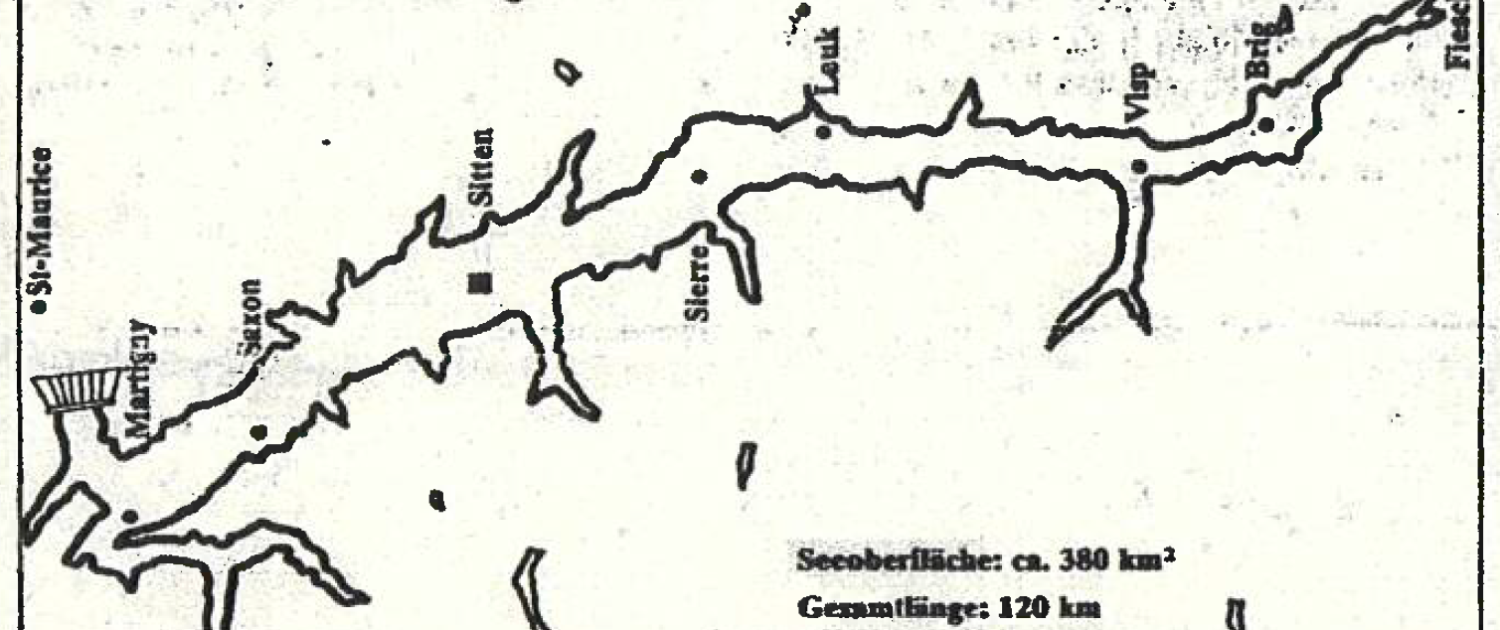What if the Valais became a dam lake?
The idea of building a huge dam at the Rhone bend in the Valais is often referred to as a joke. A lake would cover the plain and leave the valleys and their ski resorts safe. Did a project really exist as mentioned in a German-language newspaper clipping in 1978? Was the federal government planning to sink the Rhone Valley? We looked into it.
Let's go back to 1978, the first of April to be precise. The "Magazin" of the Tagesanzeiger contained an article with the evocative title "Das Wallis-Projekt: Ein (fast) begrabenes Vorhaben in neuer Auflage?" which translates into French as "Le projet Valais: une nouvelle version d'un projet (presque) enterré? In a Switzerland that is questioning its nuclear future and its electricity supply (yes, we are talking about 1978), there is talk of the construction of a 575 meter high dam with a crown of 2975 meters between the villages of Collonges and Dorénaz just below Martigny. A construction site that would last 16 years. The limit of the reservoir's level would be 1000 metres, which would swallow up the Valais plain and the valley bottoms for a lake rising as far as Brig. This is what the secret "Valais 2000" dossier contains. This is an important project at a time when it has to be decided whether to continue with nuclear power in Switzerland or whether this huge dam would not be a simpler solution.
The aim of "Valais 2000" was to secure the supply of our country with a dam and its hydroelectric power station. Proof of planning can be found in geological surveys carried out in 1971 in the vicinity of Saint-Maurice, where the Rhone valley narrows, making it suitable for the creation of a dam.
In the article, the journalist also notes that the social impact has been evaluated. It would be necessary to move 150,000 Valaisans living in the plains (the canton then has 206,000 inhabitants) to the valleys. This would have the advantage of repopulating them. On the economic level, the disappearance of fruit trees and vines would be compensated by lake tourism and the financial spin-offs from electricity production. Jobs would also be possible in these "new resorts".
The article by Paul Aufdermaur (Paul Surlemur) highlighted a project that could have been a solution to the construction of additional nuclear power stations in Switzerland. In the end, "Valais 2000" never seems to have come out of the cupboard of the Federal Office for Water Management (since integrated into the SFOE).
Fabien Lüthi, Communication Swiss Federal Office of Energy
Images: "Magazin" Tages Anzeiger 1978
- „Magazin“ Tages Anzeiger 1978
- „Magazin“ Tages Anzeiger 1978
- „Magazin“ Tages Anzeiger 1978
In 2011, the SFOE received a request from an SRF journalist who was interested in this "forgotten" project. After extensive in-house research with experts in hydropower and dam monitoring no trace of such a project was found. Quick calculations were made to see if such a project could have been imagined, but it soon became apparent that it was impossible and not viable from a hydrological and economic point of view. In addition, the size of the wall was impossible. After all the research by SRF and the SFOE, it all turned out to be a subtle April fool's joke
. Another mega dam project had been presented in another context in the canton of Uri about ten years before, and this time it really was. We will come back to this story in a future publication.
 Tages-Anzeiger 1978
Tages-Anzeiger 1978



 Gamla Uppsala BussUpgrade für Biogas-Anlagen
Gamla Uppsala BussUpgrade für Biogas-Anlagen  BFEAngehende Nuklearingenieurinnen und Nuklearingenieure aus den USA besuchen das BFE
BFEAngehende Nuklearingenieurinnen und Nuklearingenieure aus den USA besuchen das BFE  shutterstockProKilowatt senkt den Stromverbrauch auf dem Eisfeld und für das Trocknen von Bündnerfleisch
shutterstockProKilowatt senkt den Stromverbrauch auf dem Eisfeld und für das Trocknen von Bündnerfleisch  CarPostalAméliorer la collaboration entre entités publiques et startups cleantech
CarPostalAméliorer la collaboration entre entités publiques et startups cleantech 
 BFE
BFE shutterstock
shutterstock
Dieser Aprilscherz könnte wieder aktuell werden. Denn mit dem Klimawandel wird das Tal immer mehr versteppen weil das Wasser der Rhone nicht für die Bewässerung reicht.
In dem erwähnten Tages Anzeiger Magazin war eine ausführliche Studie der ETH Zürich über die technischen. volkswirtschaflichen und geologischen Details enthalten.
Der Staudamm sollte ca. 100m Höhe haben. Die Leistung des Wasserkraftwerkes ca wie ein AKW. Das wäre eine Touristenattraktion.
Derart realistisch, dass es im Wallis eine grosse Empörung darüber gab weil der Aprilscherz nur als Vertuschung bezeichnet wurde.